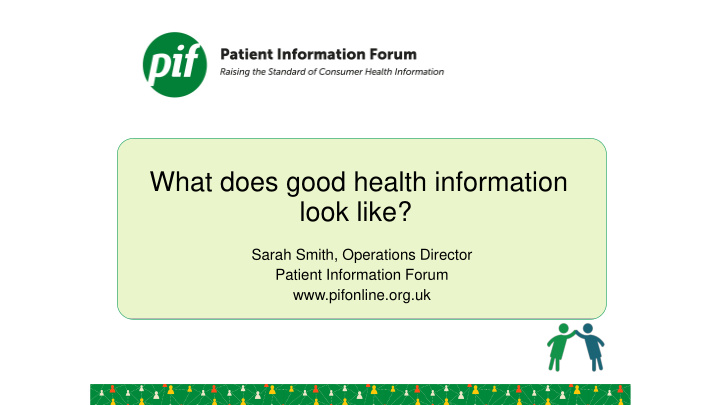



What does good health information look like? Sarah Smith, Operations Director Patient Information Forum www.pifonline.org.uk
The background • The quality of health information varies widely • Expertise, knowledge and skills are in the hands of a few people and organisations • There are no national standards or widely used guidelines for developing resources • B est practice isn’t systematically, easily or widely shared
The project • Initially a project to develop national standards for developing health information resources, supported by a comprehensive guide • Aimed at helping anyone who communicates with patients and the public about their health to improve what they produce • Department of Health funded • Part of a wider project to raise the quality and improve the reach of health information • Had to fit in with existing schemes and projects, such as the Information Standard and NHS Branding Guidelines for patient information • Had to be user led, credible and robust and easy to use and engage with
The Steering Group • 20 members, cross sector and including NICE, NHS Choices, patient.co.uk, NHS England, Bupa, voluntary sector, NHS and commercial organisations • Produced a scoping brief outlining the project • Held a series of teleconferences • Wanted guidance and practical tools, not standards • Information producers not PiF to set the agenda and decide what guidance was needed
Open Space Events Lots of common ground across both events • A kind of ‘un - conference’ Many cross cutting topic • No agenda or areas in the discussions presentations, attendees set People wanted to discuss this when they arrive a much broader range of • Entire day discussion issues than had been based with a facilitator anticipated • Two events, one in London Issues similar across and one in Manchester sectors though some had very specific issues • 40 separate discussions took place Everyone had a great deal to contribute as well as • Attendees prioritise topics learn
Findings Huge amount of information gathered, some guidance related, some further work and some campaigning issues Discussion groups looked at every aspect of information – from planning through to evaluation Some areas there was an assumption of existing best practice Four main topic areas emerged: • User-centered information – user involvement, engagement, testing, targeting information • Different information formats and audiences – print, online, digital etc • Readability and clear communication – language, tone, design, navigability, accessibility, evidence base etc • Evaluation – of resource itself and of the impact it has
Follow up event Evidence based where possible Case studies and practical • Took place in London last examples week ‘How to’ guides • Smaller and more focused Template documents, project event planning sheets, standard • Attendees were steering questions and checklists group members, plus previous Graded levels of engagement – attendees for people who are new through • Took each of the four main to the very experienced areas and discussed in more ‘Less is more’ detail Lead by example • Looking at what should be covered, what guidance was Use existing resources needed and what format these should be in
Next steps • Report from the follow up event • Literature review for evidence • Engagement with the steering group and key stakeholders • Online survey/voting • Developing actual guidance • Promotion, dissemination and use • Evaluation
And the rest……. • Good practice database • Revised and updated guides to producing information for children and young people and quality information (including guidance for providers) • Evaluating our Case for Information Report • Event in Manchester on information for the ‘hard to reach’
Recommend
More recommend